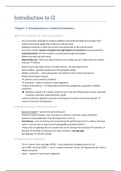Samenvatting
Summary Advanced Economic Aspects of Cultural Industries READINGS (BA 3, Term 3)
- Instelling
- Erasmus Universiteit Rotterdam (EUR)
Readings summaries for the course Advanced Economic Aspects of Cultural Industries tutorial notes. Includes the following chapters: Textbook of Cultural Economics (Towse): chapters 1, 2, 3, 5, 6, 14 A Handbook of Cultural Economics (Towse): chapters 16 - Creative economy, 17 - Creative industries...
[Meer zien]





